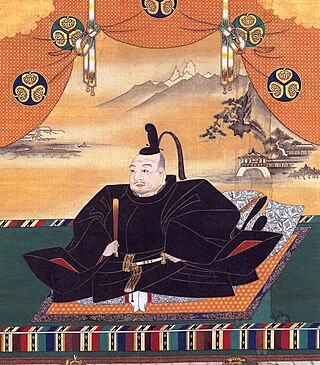
Tokugawa Ieyasu was the founder and first shōgun of the Tokugawa Shogunate of Japan, which ruled from 1603 until the Meiji Restoration in 1868. He was one of the three "Great Unifiers" of Japan, along with his former lord Oda Nobunaga and fellow Oda subordinate Toyotomi Hideyoshi. The son of a minor daimyo, Ieyasu once lived as a hostage under daimyo Imagawa Yoshimoto on behalf of his father. He later succeeded as daimyo after his father's death, serving as a vassal and general of the Oda clan, and building up his strength under Oda Nobunaga.
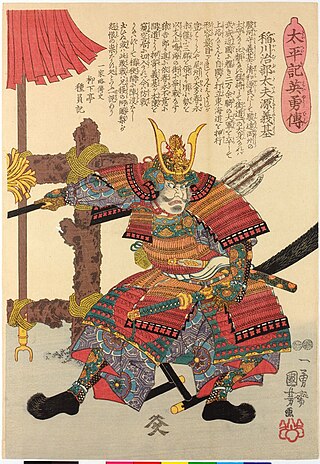
Imagawa Yoshimoto was a Japanese daimyō of the Sengoku period. Based in Suruga Province, he was known as "The number one Daimyō in the Tōkaidō; he was one of the three daimyō that dominated the Tōkaidō region. He died in 1560 while marching to Kyoto to become Shogun. He was killed in the village of Dengakuhazama in Okehazama by Oda Nobunaga.

Takeda Shingen was daimyo of Kai Province during the Sengoku period of Japan. Known as the "Tiger of Kai", he was one of the most powerful daimyo with exceptional military prestige in the late stage of the Sengoku period. Shingen was based in a poor area with little arable land and no sea, but became one of Japan's leading daimyo. His skills are highly evaluated along with Mōri Motonari.

Shinshiro is a city located in Aichi Prefecture, Japan. As of 1 October 2019, the city had an estimated population of 44,581 in 17,691 households, and a population density of 89.3 persons per km². The total area of the city is 499.23 square kilometres (192.75 sq mi).

Akiyama Nobutomo was a samurai during the Sengoku period in Japan. He is known as one of the "Twenty-Four Generals of Takeda Shingen". Nobutomo also served under Shingen's son, Takeda Katsuyori.

The Battle of Mikatagahara was a battle of the Sengoku period of Japan fought between Takeda Shingen and Tokugawa Ieyasu in Mikatagahara, Tōtōmi Province on 25 January 1573. Shingen attacked Ieyasu at the plain of Mikatagahara north of Hamamatsu during his campaign against Oda Nobunaga while seeking a route from Kōfu to Kyoto. The Tokugawa-Oda force was almost totally annihilated by the Takeda after being encircled and many of Ieyasu's retainers were killed in the battle. Ieyasu and his surviving men were forced to retreat before launching a minor counterattack to delay Shingen's march towards Kyoto.

Nagashino Castle was a Sengoku period Japanese castle located in what is now Shinshiro, eastern Aichi Prefecture, Japan. It is noteworthy as the site of the crucial Battle of Nagashino between the combined forces of Tokugawa Ieyasu and Oda Nobunaga against Takeda Katsuyori in 1575. The ruins have been protected as a National Historic Site since 1929, the first time a former castle site had received such protection.
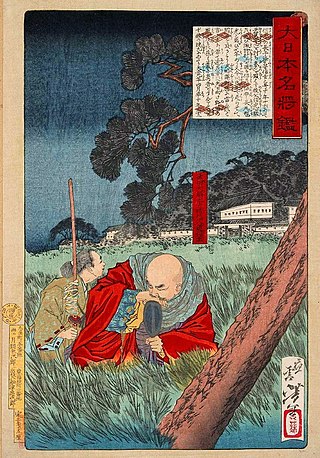
The Siege of Noda Castle (野田城の戦い) took place from January to February 1573, between the forces of the Takeda clan, led by the noted warlord Takeda Shingen, against the Tokugawa clan, led by Tokugawa Ieyasu. Along with the Battle of Mikatagahara it was one of the final battles in Takeda Shingen's long career.
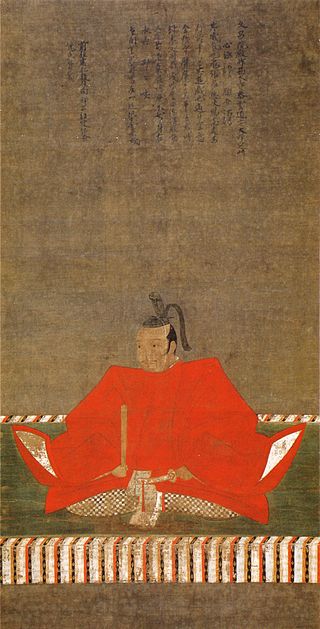
Okudaira Nobumasa called Okudaira Sadamasa, was a Japanese daimyō of the Sengoku and early Edo periods. Nobumasa's family considered their origins to have been associated with Mikawa Province. The clan was descended through the Akamatsu from the Murakami-Genji.

Sanada Masayuki was a Japanese Sengoku period lord and daimyō. He was the head of Sanada clan, a regional house of Shinano Province, which became a vassal of the Takeda clan of Kai Province.
Imagawa Ujizane was a Japanese daimyō who lived in the Sengoku through early Edo periods. He was the tenth head of the Imagawa clan, and was a son of Imagawa Yoshimoto and the father of Imagawa Norimochi and Shinagawa Takahisa.

Takeda Nobushige was a samurai of Japan's Sengoku period, and younger brother of Takeda Shingen. He was known as one of the "Twenty-Four Generals of Takeda Shingen".

Iwamura Castle was located in the southeastern area of Mino Province in Japan. Its ruins can be found in the modern-day municipal subdivision of Iwamura, in Ena, Gifu Prefecture. Along with Takatori Castle in Nara and Bitchu-Matsuyama Castle in Okayama, it is regarded as one of the three best mountain castles, and at an elevation of 721 meters above sea level, it is one of the highest in Japan.

Hōjō Ujiyasu was a daimyō (warlord) and third head of the Odawara Hōjō clan. Known as the "Lion of Sagami", he was revered as a fearsome warrior and a cunning man. He is famous for his strategies of breaking the siege from Takeda Shingen and Uesugi Kenshin. A son of Hōjō Ujitsuna, his only known wife was Imagawa Yoshimoto's sister, Zuikei-in. Among his sons are Hōjō Ujimasa and Uesugi Kagetora.
Suganuma Sadamichi was a samurai commander during Japan's Sengoku period, who served Tokugawa Ieyasu.
The siege of Shika castle, which took place in September 1547, was one of many battles fought in Takeda Shingen's bid to seize control of Shinano Province.

Nirengi Castle was a Japanese castle in what is now the city of Toyohashi, Aichi Prefecture, during the Sengoku period. There are no extant structures left; however, a park was built on the site where the castle once stood, and a stone monument and some explanatory signboards were erected by the city.

Minowa Castle was a "hirayama"-style (castle located in the Misato neighborhood of the city of Takasaki, Gunma Prefecture, Japan. The ruins have been protected by the central government as a National Historic Site since 1987.
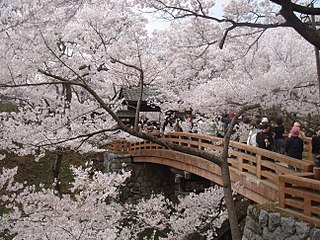
Takatō Castle is a Japanese castle located in the city of Ina, southern Nagano Prefecture, Japan. At the end of the Edo period, Takatō Castle was home to a cadet branch of the Naitō clan, daimyō of Takatō Domain. The castle was also known as Kabuto Castle. Built sometime in the 16th century, it is now largely ruins.

Takiyama Castle was a Japanese castle located in what is now the Tani neighborhood of the city of Hachiōji, Tokyo, Japan. Its ruins have protected as a National Historic Site since 2007.



















